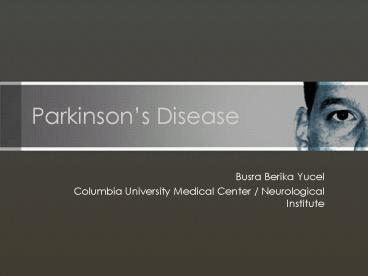Parkinson - PowerPoint PPT Presentation
Title:
Parkinson
Description:
Parkinson s Disease Busra Berika Yucel Columbia University Medical Center / Neurological Institute History of Parkinson s Disease Parkinson s disease was first ... – PowerPoint PPT presentation
Number of Views:108
Avg rating:3.0/5.0
Title: Parkinson
1
Parkinsons Disease
- Busra Berika Yucel
- Columbia University Medical Center / Neurological
Institute
2
History of Parkinsons Disease
- Parkinsons disease was first described by James
Parkinson in his Essay on the Shaking Palsy in
1817. James Parkinson was a physician and surgeon
practicing in London. In his words, shaking
palsy, which we call Parkinsons now, was
described as
3
Shaking Palsy
- Involuntary tremulous motion, with lessened
muscular power, in parts not in action and even
when supported with a propensity to bend the
trunk forwards, and to pass from a walking to
running pace the senses and intellect being
injured. - James Parkinson
4
Symptoms
- By looking at his article we can clearly say
that the main symptoms of the disease are -
Tremor - Stiffness (rigidity) - Bradykinesia
(slowness of bodily movement)
5
Tremor
- It is the symptom which usually first comes to
patients attention. - Typically, tremor occurs when the affected hand
or foot is at rest. - It disappears during sleep or when the patient is
resting quietly. - Nervousness and being under stress enhances the
tremor.
6
Bradykinesia
- Muscular rigidity slows movement.
- Loss of automatic movements- swinging arms
while walking- eye blinking- expressive
movements of the - face and hands
7
Stiffness (rigidity)
- There is often a regular, jerky quality to the
resistance as if there was a ratchet gear or
cogged wheel in the joint being manipulated. - Physicians call this as cogwheel rigidity
8
Symptoms (cont.)
- Other symptoms of disease include- tendency to
stand in a - stooped posture- walking with short,
shuffling - steps- change in tone- decrease in facial
expressions- memory problems
9
Other signs
- While they are writing, their writing goes
upwards instead of straight. - Lose their face expression
- Decreased tone while talking
- They have difficulty with swallowing. Their food
might accidentally go to trachea - Personality changes
- There is difficulty with turning in bed
- There is drooling day night
- Stoop position, not swinging arms while walking
- While driving, they might make a big swipe turn
to left, and small turn to right (which may cause
an accident) - Eyes may stare at one point
10
Cause
- There is not a clear answer for the cause of the
disease, but its known to be related to a
chemical substance called dopamine.
11
Dopamine
- Dopamine is a chemical naturally produced in the
body. In the brain, dopamine functions as a
neurotransmitter, activating dopamine receptors. - Since dopamine cannot cross the blood-brain
barrier, dopamine given as a drug does not
directly affect the central nervous system. - Shortage of dopamine, particularly the death of
dopamine neurons in the nigrostriatal pathway,
causes Parkinson's disease, in which a person
loses the ability to execute smooth, controlled
movements.
12
Michael J. Fox
- Michael J. Fox was diagnosed with Parkinsons in
1991, when he was 30. - He has the biggest foundation of Parkinsons
disease research, which is Michael J. Fox
Foundation for Parkinson's Research
13
Muhammad Ali
- He had signs of decreasing motor skills during a
fight against Larry Holmes in 1980. - It was noted that his illness was probably
brought on by repetitive head trauma. - There is a Muhammad Ali Parkinson Research Center
at Barrow Neurological Institute
14
Treatments
- Surgery
- Surgery may be used to control symptoms of
Parkinson's disease and improve the quality of
life when medication ceases to be effective or
when medication side effects, such as jerking and
dyskinesias, become intolerable. - Only about 10 of Parkinson's patients are
estimated to be suitable candidates for surgery.
15
Treatments (cont.)
- Medication
- Medication could also be used as a treatment of
Parkinsons Disease. The main medicine to treat
Parkinsons is Sinemet. Sinemet is a combination
of Carbidopa and Levadopa. (Levodopa is a prodrug
that is converted to dopamine by DOPA
decarboxylase and can cross the blood-brain
barrier) - But there are some side effects of Sinemet it
might have reactions with proteins, such as milk
and milk products might lead to some involuntary
activities when it is not used in the right dose
and it also causes tendency to sleep.
16
Current Research about Parkinsons Disease
- There is a research being done about stem cell
therapy, where you inject dopamine to stem cells.
Since stem cells are part of the nervous system,
it is suppose to effect directly to brain. - Doing exercise is also being research it seems,
it helps Parkinsons patients to lose some of
their symptoms.
17
References
- Parkinsons Disease Roger C. Duvoisin, M.D
- www.parkinson.org
- http//menshealth.about.com/od/diseases/f/parkinso
n_nine.htm - http//neurologicalillness.suite101.com/article.cf
m/muhammad_alis_fight - http//www.maprc.com
- http//www.neurologychannel.com/parkinsonsdisease/
surgery.shtml - http//www.3dchem.com/molecules.asp?ID289
18
Acknowledgements
- Dr. Karen Bell
- Dr. Lucien Cote
- CUMC
- HCS staff
- Dr. Sat
- Audience
19
Any questions ?































